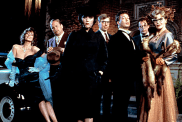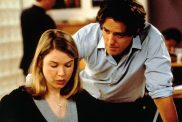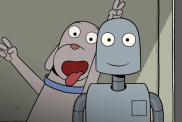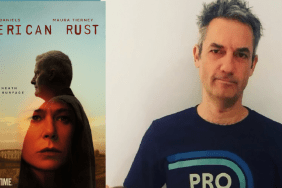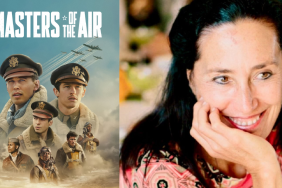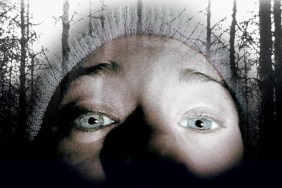
Another awesome with the man behind THE WITCH.
We’ve been doing our part to put director Robert Eggers’ THE WITCH in your face as much as possible. Not just because the movie is just as an authentically unsettling experience as you’ve heard (read our raving review HERE), but because a horror film this dark, strange, cerebral and defiantly anti-commercial doesn’t belong in the multiplexes across the world.
Not in today’s mass-produced, trend-sucking cinematic landscape, anyway.
No, THE WITCH is an anomaly. And a brilliant one at that.
And though we’ve interviewed Eggers a few times for SHOCK, we couldn’t resist adding yet another discussion with the man, this one banked by our beloved Italian correspondent Roberto D’Onofrio last fall at the 2015 Sitges film festival, during THE WITCH’s European premiere.
So, once again, here’s some words with the visionary Eggers…Italian style.

SHOCK: This wasnt an easy film to make and you took a long time to get it produced, could you tell us how it all started?
EGGERS: Yes, you are right. I have spent so many years on this movie, I tried to make a lot of films, and no one wanted to make them. They were too weird, too obscure, then I thought: I have to make a genre film thats personal to me, if Im going to make a genre film, it has to be personal and it has to be good. Im from Lee, New Hampshire, one of the six states part of New England region, New Englands past was always part of my conscious, growing up, we always had stories of THE WITCH in the woods or THE WITCH down the block, I tried to go to Salem every Halloween and I was always disappointed that The Witches werent real, THE WITCH trials didnt even happen in Salem, they happened in a place called Salem Village, which is now called Danvers. I have always been into folktales and fairy tales and New Englands past, so with this film I wanted to create an archetypal New England horror story. Something that would feel like an inherited nightmare of a Puritan family. This was a way to sort of get back to that childhood place and return to this New England subject. THE WITCH took four years to get financing, I was really lucky that when I found investors, they really wanted to make the picture that I wanted to make, I had a lot of freedom, and could cast who I wanted.
SHOCK: THE WITCH that abducts the baby seems to be able to turn into an animal, how did you create this character and her powers?
EGGERS: I did research on what were the beliefs about Witches at that time, concentrating on New England and England, where this family comes from. So, there is nothing in the film which is my invention, this is all things that according to people, Witches did. The kind of research I did was wild and obsessive, growing up in New Hampshire it wasnt hard to visualize what life could have been like in the 1600s. I further explored my visionary ideas with a thorough reading of period literature, old diaries and letters and historic sources, such as the Geneva Bible and Elizabethan witch pamphlets, I also spent time at the Plymouth Plantation, the living history museum based in Plymouth, Massachusetts. It was tons and tons of reading of everything, from primary source material from different people, to try to understand the early modern period, the different versions of English Calvinism, the kinds of people who moved over there, to things that helped me understand the agricultural life. My bookshelf is full of things like The English Husbandman, written in that period. But Im sure if I were to try and start a 17th century farm, I would definitely die. So it was a lot of stuff to go through. We also worked with a lot of excellent museums and some real experts in the field as well. If you read the plentiful sources available, modern audiences would be shocked by the power, the exoticism and the bizarreness that has been alluded to witches over the centuries. I even read an account, of a woman put on trial for giving a girl a poisoned apple, and that was before written stories of Snow White were published. I drew from things like the brothers Grimm, the golden age of illustration, is a big visual influence on me, for my whole life. In this period, the fairy tale world and the real world for most people were the same thing. I can think back to my childhood when witches were real and terrifying. I wanted to highlight all of the fairy tale references weve all grown up with.
SHOCK: I found the family drama more frightening than the supernatural scenes, especially the moment in which the members of the family are confronting each other, how did you build it up?
EGGERS: I believe the family drama is the more interesting kind of drama, if you think of Hamlet and King Lear they are generally considered the best Shakespeare plays, and thats because of the family subject. Therefore, when the family dynamics go wacky, I think that is just the most terrifying moment. I had like a dollhouse in my imagination, with the house and the characters and everything in it, when I was writing the scenes, so I very much knew what I wanted when I went into rehearsal. We were very fortunate, given my budgetary level, to have a week of rehearsals where we really worked together to build this family, but Ralph Ineson playing the father, brought in so much more to the movie, he was able to be very collaborative, and Kate Dickie as the mother in particular was amazing, she completely immersed herself in her role, she sort of becomes possessed by it, when we were rehearsing in the hotel basement, she was like she was really becoming her character, she was a volcano, and Anya did a fantastic job, this is her first leading role and she is amazing. I was very lucky to be working with these extremely great actors whom helped me to bring these scenes to this level.
SHOCK: Religion has a very important part in building up the movie
EGGERS: Yes, it was the basis from where I started writing the story. New England was founded by these extreme English Calvinists, so this was the right way to tell this story. Im into dark things, this is the kind of stuff that Im interested in. Fairy tales, ghost stories, mythology, and religion, all of these often have super dark undertones and these are the imaginary landscapes I like to go in.
SHOCK: There is that old showbiz adage that you should never work with children or animals, but you had both. Was it hard working with children?
EGGERS: I knew the shoot was going to be really tough and we needed people who were going to trust and care about each other, me and casting director Kharmel Cochrane expanded our search to schools across the north of England, we thought it was crucial that the youngest actors use their native accents. I kept thinking of the younger boys imitating accents and I thought that was just nuts, I didnt want the authenticity of their performances to fall apart. I was lucky enough to cast people who were appropriate for the roles, excellent actors, but also people that would be good people and with whom I worked well. The kids were a pleasure and it was very easy to work with them, the only obstacle was that children filming hours are very short and was difficult to schedule them, also because we needed cloudy weather at all time and it was quite cold there. The kids had a very Disney-fied idea of what this story was, with the little kids there was a lot of mannequin acting where youd go: Stand there, open your mouth a little bit, breathe, then you put in a witch and add some music and it seems terrifying. The littlest kids did not see the movie, but the other ones have. I was not afraid of working with kids and I really enjoyed it, there are many adults that are way harder to work with than children. Working with animals instead was a real nightmare, the raven and the hare were super well trained and always hit their mark and did everything right, which was kind of amazing, but the goats were just awful. Although I dont blame the goat for being stubborn and not wanting to be in the movie. Id never had to deal with or been so reliant on animals before, so that was challenging. After speaking to the animal trainer for the first time, I just put my head down and wondered what Id done. So every day was just wild and the challenges were pretty epic.
SHOCK: The art direction is very accurate, the location, the costumes, everything is an extraordinarily authentic reproduction. Where did you shoot the movie and how you recreated that period?
EGGERS: We actually had to shoot the film in Canada as New Hampshire doesnt have a Tax Credit incentive system like Canada, which paid for half of this movie. Filming on THE WITCH took place over twenty six days in Kiosk, a small, abandoned lumber town in Northern Ontario. We found a small open field that was surrounded by large white pines and hemlock, and we knew it was the spot. The area we were shooting in was extremely remote, like sixty people living in it, the nearest town was also very small, actually being in a rural area was perfect for this film, but working in an extremely remote location meant no WI-Fi or phone service and it was a logistic challenge for both cast and crew. Craig Lathrop, the production designer, did an incredibly uncompromising job. We had to build everything because those kind of houses dont exist anymore, theyve been turned into buildings. But we were able to find cooperative people there, local carpenters were really incredible, many of them were just farmers who knew how to do carpentry as part of the things they need to do in their everyday life, much like it was in the 17th century. Because the film was contained mainly to the farm, I knew what I wanted in terms of family possessions and the layout of the house. There were certain things that we couldnt get in Canada, as the hand-riven oak clapboards to sheath the structures, which is a kind of architectural technique that doesnt exist in Canada, so we had to have a guy, who was one of the few people knowing how to do it, in Massachusetts, do that, ship it up and then we could build the set. Everything you see on camera was made from the authentic material, which often meant having to use the authentic tools to make it right. We used all the building materials that would have been accurate to the period, as well as accurate clothing, which were realized by Linda Muir, who was dealing with me, coming in all the time with new drawings.
SHOCK: Writing your movie you obviously were inspired by the Salem trials, depicting Witches and their evildoings do you sort of justify their prosecution?
EGGERS: I dont think that my film validates the Salem Witch trials, that would not be good, many women were falsely accused of witchcraft and tortured, Im not saying they should have been murdered because they were Witches, that wasnt my intention, but ambiguity is important to me and I like to play with that, and there are some things in the movie that I left to interpretation. I was also inspired by fairy tales because they are multifaceted and even in Disney they are moralizing real life, and that makes them very truthful and human, and Im interested in that. In the early modern period fairy tales and the real world were really much the same thing, therefore I wanted to highlight all of the fairy tale references weve all grown up with. The question I am posing with this movie is: what does THE WITCH motif mean to todays society?
SHOCK: The grey colors of the landscapes and the dark photography of the film surely added a lot to the disquieting atmosphere of the tale, how did you create that?
EGGERS: I have to give credit to my cinematographer Jarin Blaschke, who worked with me on my previous two shorts, for creating the overriding ominous tone of the film. With the exception of night exteriors, it is all natural light and flame, we used predominantly natural light for exteriors, while for all of the night interiors we had a single flame fashioned from customised triple wicks that you could get exposure with, and we had flame bars off camera. For the one shot with the raven, we had an electric bulb that was flickering, because the fire would have scared the raven. I was inspired by the Goya paintings and by Golden Age fairy tale illustrations, they had a big visual influence on me, I wanted the same kind of light for the movie, in order to create a restrained sense of the fantastical.
SHOCK: What director or directors have influenced you the most?
EGGERS: In terms of cinematic influences, I really love Bergman and Dryer, and you can definitely see that in THE WITCH. I would also say that this movie owes more to The Shining, which Ive seen more than any other movie, than a lot of other things. Murnau is another one of my favorite filmmakers. Well, Im realizing I like a lot of dead people!!
SHOCK: Ive heard rumors that you will be remaking Nosferatu and on your website you published some drawings about it, can you tell us more about the project?
EGGERS: Well, “Nosferatu” is in the future, although its not the picture I am working on currently, it will have nothing to do with the Werner Herzog movie, I will take some inspiration from the original 1922 F.W. Murnau movie but I will write a new script from that. Right now I am developing a medieval knight movie, a fantasy with angels and demons. Similarly to THE WITCH, it will contains the sort of fantastical beliefs that these creatures exist in our reality. Its tentatively titled The Knight. The film is still in early pre-production stages, its an epic movie that I hope to get made, its something Ive wanted to do since I was a child, but I have to write it for an adult me.
The Witch
-
The Witch

-
The Witch

